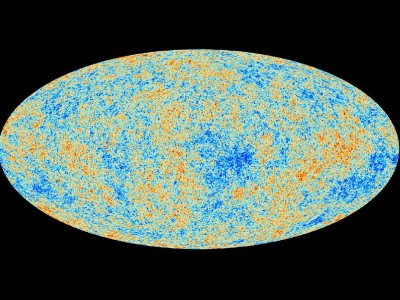
Image credit: ESA and the Planck Collaboration
Led by the European Space Agency (ESA) and launched in 2009, the Planck mission is a cooperative effort involving mission-enabling technology from NASA used by scientists from the U.S., Europe and Canada. Years of scanning the skies, the map of the universe from the Planck data provides scientists with a snapshot of the universe 370,000 years after the big bang. Scientists say that this is the earliest we can look back because, although light existed before this time, it was locked in a hot plasma similar to a candle flame, which later cooled and set the light free.
“Astronomers worldwide have been on the edge of their seats waiting for this map,” said Joan Centrella, Planck program scientist at NASA Headquarters in Washington. “These measurements are profoundly important to many areas of science, as well as future space missions. We are so pleased to have worked with the European Space Agency on such a historic endeavor.”
The Planck map of the universe is based on data collected over only the first 15.5 months of all-sky observations and suggests that the universe is expanding more slowly than scientists thought. Additionally, it appears that the age of the universe may be about 100 million years older than earlier estimates, now closer to about 13.8 billion years.
What can be seen in the Planck universe map image are tiny temperature fluctuations in what astronomers call the cosmic microwave background. These patterns of ancient light, which has traveled since nearly the dawn of the universe, represent the seeds of galaxies and clusters of galaxies we see around us today.
“As that ancient light travels to us, matter acts like an obstacle course getting in its way and changing the patterns slightly,” said Charles Lawrence, the U.S. project scientist for Planck at NASA’s Jet Propulsion Laboratory (JPL) in Pasadena, Calif. “The Planck map reveals not only the very young universe, but also matter, including dark matter, everywhere in the universe.”
Recent calculations have concluded that there does not appear to be enough visible matter in the universe to account for the behavior of the current expansion we see. This has led to the theory of what it called ‘dark matter’ to account for the missing mass, and dark energy – a force pushing to expand the universe. Data from Planck now shows there is less dark energy and more matter, both normal and dark matter, in the universe than previously known.
The new estimate of dark matter content in the universe is 26.8 percent, up from 24 percent, while dark energy falls to 68.3 percent, down from 71.4 percent. Normal matter now is 4.9 percent, up from 4.6 percent.
According to NASA, the Planck findings have begun to rule out many complex inflation theories which describe the very early and rapid expansion of the universe. The more random distribution of matter suggests that random processes were at play in the very early universe on minute “quantum” scales, favoring much simpler inflation theories.
Planck data now shows the current expansion rate of the universe, known as Hubble’s constant, to be 67.15 plus or minus 1.2 kilometers/second/megaparsec. A megaparsec is roughly 3 million light-years.
Complete mission information on Planck is available on NASA’s web site at: http://www.nasa.gov/planck
![Herbal Reference Substances are Key to Everyday Products <!-- AddThis Sharing Buttons above -->
<div class="addthis_toolbox addthis_default_style " addthis:url='http://newstaar.com/herbal-reference-substances-are-key-to-everyday-products/3512112/' >
<a class="addthis_button_facebook_like" fb:like:layout="button_count"></a>
<a class="addthis_button_tweet"></a>
<a class="addthis_button_pinterest_pinit"></a>
<a class="addthis_counter addthis_pill_style"></a>
</div>When it comes to quality control testing and the development of new products, Botanical Reference Materials (BRMs), also known as Herbal References are critically important. To help companies ultimately obtain all-important FDA approval, the Food and Drug Administration provides in its guidance a recommendation that […]<!-- AddThis Sharing Buttons below -->
<div class="addthis_toolbox addthis_default_style addthis_32x32_style" addthis:url='http://newstaar.com/herbal-reference-substances-are-key-to-everyday-products/3512112/' >
<a class="addthis_button_preferred_1"></a>
<a class="addthis_button_preferred_2"></a>
<a class="addthis_button_preferred_3"></a>
<a class="addthis_button_preferred_4"></a>
<a class="addthis_button_compact"></a>
<a class="addthis_counter addthis_bubble_style"></a>
</div>](http://newstaar.com/wp-content/uploads/2021/02/Achillea_millefolium_flowers-100x100.jpg)
![Quality Electrochemical Biosensors are Critical for Medical, Food and Chemical Industry <!-- AddThis Sharing Buttons above -->
<div class="addthis_toolbox addthis_default_style " addthis:url='http://newstaar.com/quality-electrochemical-biosensors-are-critical-for-medical-food-and-chemical-industry/3512086/' >
<a class="addthis_button_facebook_like" fb:like:layout="button_count"></a>
<a class="addthis_button_tweet"></a>
<a class="addthis_button_pinterest_pinit"></a>
<a class="addthis_counter addthis_pill_style"></a>
</div>A number of industries have, at their core, a need to frequent or even continuous analysis of biological media. These include the medical and pharmaceutical fields, biotech firms, and food and chemical companies. To maintain quality standards and develop new products, these industries rely heavily […]<!-- AddThis Sharing Buttons below -->
<div class="addthis_toolbox addthis_default_style addthis_32x32_style" addthis:url='http://newstaar.com/quality-electrochemical-biosensors-are-critical-for-medical-food-and-chemical-industry/3512086/' >
<a class="addthis_button_preferred_1"></a>
<a class="addthis_button_preferred_2"></a>
<a class="addthis_button_preferred_3"></a>
<a class="addthis_button_preferred_4"></a>
<a class="addthis_button_compact"></a>
<a class="addthis_counter addthis_bubble_style"></a>
</div>](http://newstaar.com/wp-content/uploads/2020/10/Electrochemical-Biosensor-100x100.jpg)
![Company Develops Industrial Mixers Well-Suited for both Fragile and Explosive Products <!-- AddThis Sharing Buttons above -->
<div class="addthis_toolbox addthis_default_style " addthis:url='http://newstaar.com/company-develops-industrial-mixers-well-suited-for-both-fragile-and-explosive-products/3512071/' >
<a class="addthis_button_facebook_like" fb:like:layout="button_count"></a>
<a class="addthis_button_tweet"></a>
<a class="addthis_button_pinterest_pinit"></a>
<a class="addthis_counter addthis_pill_style"></a>
</div>Industrial drum mixers are normally applied to blend mixes of varying viscosities such as adhesive slurries or cement. Some of these mixers have the capability of blending mixes of very different particle sizes such as fruit and ice cream, and gravel and cement slurry. The […]<!-- AddThis Sharing Buttons below -->
<div class="addthis_toolbox addthis_default_style addthis_32x32_style" addthis:url='http://newstaar.com/company-develops-industrial-mixers-well-suited-for-both-fragile-and-explosive-products/3512071/' >
<a class="addthis_button_preferred_1"></a>
<a class="addthis_button_preferred_2"></a>
<a class="addthis_button_preferred_3"></a>
<a class="addthis_button_preferred_4"></a>
<a class="addthis_button_compact"></a>
<a class="addthis_counter addthis_bubble_style"></a>
</div>](http://newstaar.com/wp-content/uploads/2020/06/bandeau-sofragir2-100x100.jpg)